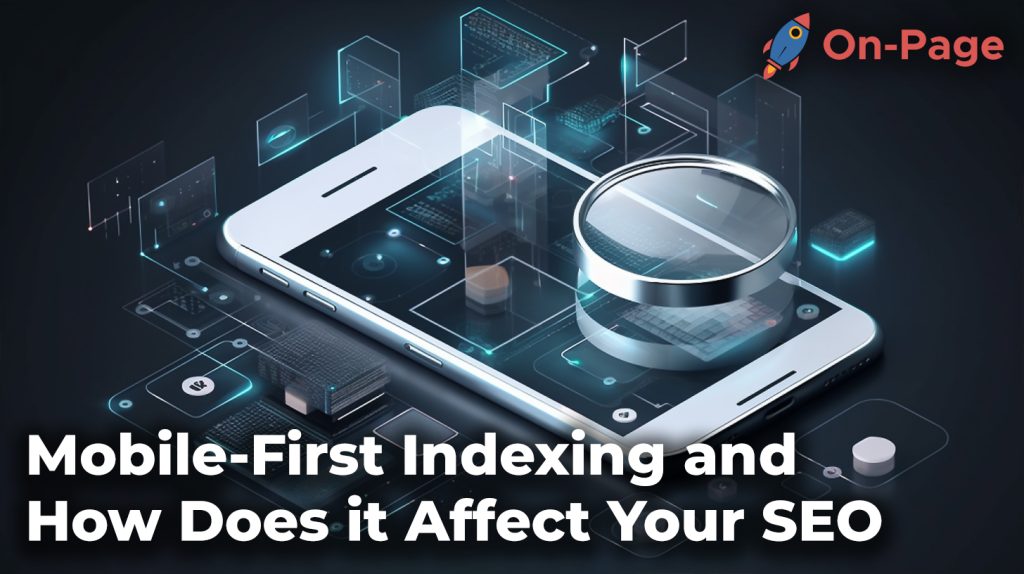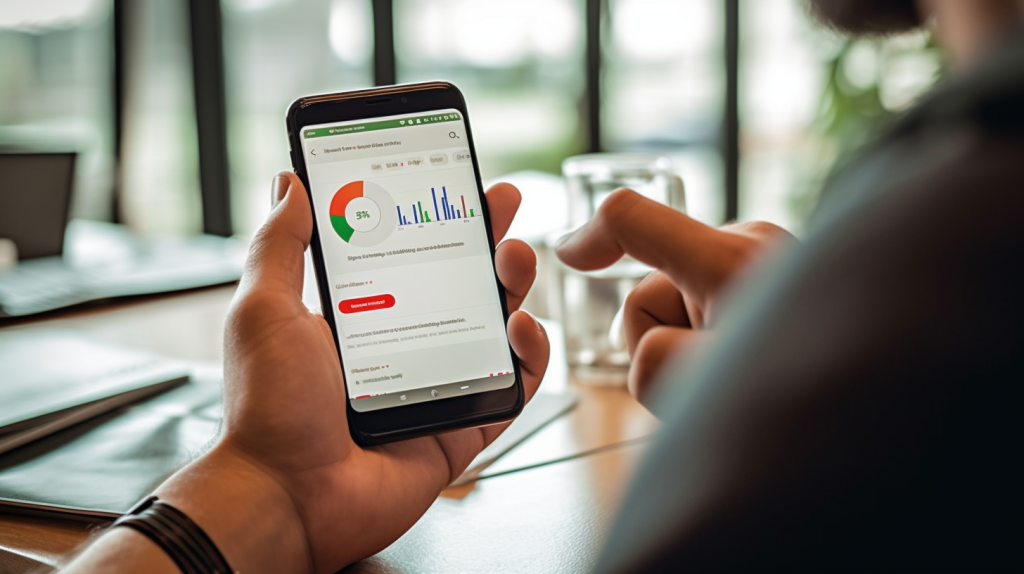
Picture yourself walking through a crowded marketplace, trying to find the best deals on your favorite products. You pull out your smartphone to compare prices, read reviews, and search for that hidden gem tucked away in a corner. You’re not alone: millions of people across the globe are doing the same every day. In fact, mobile devices account for over 50% of global web traffic, making it crucial for businesses to not only have a website but ensure it performs well on mobile screens as well. Enter Mobile-First Indexing – Google’s dexterous response to our mobile-driven world. Dive right into this comprehensive guide to learn how Mobile-First Indexing can make or break your SEO strategy and what you need to do to stay ahead of the curve!
Mobile-first indexing is a change in the way Google indexes web pages, where the mobile version of a site is prioritized over the desktop version. This means that having a mobile-friendly site is crucial for SEO since it impacts search engine ranking. To optimize for mobile-first indexing, ensure your site has a responsive design, fast load speed, easy usability, and optimized content for mobile devices.
Understanding Mobile-First Indexing
With the explosion of mobile usage globally, Google prioritized its indexing and ranking algorithms based on mobile-first website designs and configurations. This means that when Google crawls your website, it first evaluates the mobile version to compile ranking results.
To better understand this new shift in Google’s algorithms, let us compare it to a builder who is looking at a house construction plan. When building a house, you’d typically start with the foundation and then work your way up to add the roof, windows, walls, and other elements. Similarly, when Google crawls your website, it first establishes the foundation (mobile optimization) before adding other features like desktop data.
For instance, if your site has a responsive design – where content scales down while maintaining all functionalities for mobile users – it will be crawled by Googlebot before being adjusted to suit desktop devices’ requirements.
In simple terms, think of mobile-first indexing as “mobile-friendly” indexing. Essentially, Google now prioritizes sites that are optimized for mobile devices over those that are not. Suppose your site does not adhere to these guidelines. In that case, you will likely experience some downside impacts such as lower rankings or significantly reduced traffic from organic search results.
- As of March 2020, Google announced that their search engine would shift to mobile-first indexing for all websites, highlighting the growing importance of mobile-friendly sites in search engine rankings.
- In 2023, more than 60% of Google’s organic search traffic comes from mobile devices, proving that optimizing websites for mobile users is crucial for maintaining visibility on search engines.
- A survey conducted in 2019 revealed that only 13% of websites can retain the exact same ranking position across devices (mobile and desktop), emphasizing the significance of optimizing a website’s user experience and performance for both platforms.
How it Works and Its Importance
Mobile-first indexing affects how Google bots index websites since they move from desktop versions to more mobile-friendly versions that include responsive design features and other web design techniques best suited for mobile devices. It begins by hiring web crawlers to access websites before running checks on various elements such as images, videos, links, and text.
The web crawlers now prioritize mobile versions, allowing Google to opt for this version and implement ranking algorithms based on them. This move is logical; due to the steady increase in mobile usage over the years, Google intends to provide a more enjoyable browsing experience for mobile device users.
Mobile-first indexing has immense implications on your SEO efforts since it can significantly affect your website’s organic search traffic. If your site is not optimized for mobile devices, it may not fare well in search engine rankings or search results pages (SERPs), causing a decrease in traffic and conversion rates.
Think of it this way: You’re shopping for groceries at the supermarket during peak hours, and you need to navigate narrow aisles with your cart periodically moving aside to avoid collisions with other shoppers. If someone attempted to follow you with a bulky trolley in these conditions, they would inherently struggle to maneuver through the aisles quickly and efficiently, reducing productivity – this same principle applies to websites that are not optimized for mobile devices.
Furthermore, Google’s main objective is always to deliver relevant content when searchers conduct specific queries. Since 60% of organic searches come from mobile devices, it only makes sense that websites being crawled are better suited for these devices.
So far we have covered what mobile-first indexing is and why it’s important. In the next section, we will delve further into how it impacts SEO and establish measures businesses can take to optimize their sites.
Mobile-First Indexing and SEO Impact

One of the most significant impacts of mobile-first indexing is on your website’s SEO performance. With the increasing importance of mobile devices in online traffic and Google’s focus on providing the best mobile search experience, it is crucial to ensure your website is optimized for mobile-first indexing.
For example, websites that are not mobile-friendly might see a negative effect on their search engine ranking. This means that if your website does not have a responsive design or mobile version, it could significantly affect how users find you through search engines. As more and more users turn to their mobile devices for searches, this could result in a decrease in overall traffic to your website.
Furthermore, studies show that mobile-first indexing can impact the ranking of websites that are not optimized for mobile devices. A study by BrightEdge found that non-mobile-friendly websites had lower organic traffic than those optimized for mobile devices. On the other hand, sites with a mobile-responsive design ranked higher in Google’s search results.
Some experts argue that switching to a mobile-first index may not necessarily harm desktop rankings. However, as we’ve mentioned earlier, Google is moving towards 100% mobile-first indexing, which means businesses that don’t optimize their websites for mobile devices will be left behind eventually.
Now let’s explore the different factors that can affect your website’s ranking under mobile-first indexing.
Ranking Factors and Site Crawling
When it comes to ranking factors and site crawling under mobile-first indexing, there are several things you need to consider. Here are some essential factors to keep in mind:
- Quality content – The quality of your website content remains vital for ranking. However, with mobile-first indexing, it’s crucial to ensure your content is accessible and easy to read on smaller screens.
- Page speed – Research shows that mobile users have shorter attention spans and expect pages to load quickly. A fast-loading website is essential for providing a good user experience, which can positively impact your ranking.
- Mobile responsiveness – Your website must be easy to navigate on smaller screens. The design elements should adjust seamlessly, so the website is easy to read and navigate on a mobile device.
- Structured data – Structured data makes it easier for search engines to crawl and understand your website’s content. When creating structured data, ensure it’s optimized for mobile devices.
- Backlinks – Your backlink profile remains important in terms of ranking factors. However, it’s essential to ensure that mobile users can access the linked content easily.
Think of it this way: Google has always crawled desktop versions of websites to determine their relevance for indexing purposes. However, with over 60% of online searches coming from mobile devices, having a mobile-responsive website is imperative. Much like a shoe fitting perfectly, a website that works well on any device will lead to better visibility and more significant traffic.
Another example is that Google spiders will crawl the mobile version of your site first. If your website doesn’t have a responsive design or isn’t optimized for mobile devices, its crawling may take longer. This could negatively affect how quickly new content gets indexed on your pages, which means lower rankings over time.
Now that we’ve explored how mobile-first indexing affects SEO performance and the different ranking factors under this initiative let’s look at some optimization techniques you can implement on your website.
Mobile-First Optimization Techniques

As mobile-first indexing becomes the norm, it’s essential to optimize your website for mobile devices. By doing so, you can improve user experience and boost your search engine ranking. Here are some mobile-first optimization techniques:
Short-form Content: Mobile users have a shorter attention span than desktop users do. Thus, optimizing content for shorter paragraphs and using bullet points makes it more digestible.
HTML5 Videos: Embedding high-quality videos that play on mobile devices is vital to engage visitors.
Appropriate Font Size: Choosing the right font size is crucial, making it readable without zooming in or causing display issues.
Optimize Images: Properly sizing images before uploading them can reduce page load time and maintain image quality on every device. It’s like cutting vegetables before cooking to ensure an evenly cooked dish.
Reduce Pop-Ups: Avoid intrusive pop-ups and interstitials that block site content as they may discourage visitors from browsing through your site.
The above optimizations improve the user’s site experience, but there’s more optimization required to rank higher in mobile-first indexing.
Responsive Design and Site Speed

Responsive design refers to creating web pages that adapt dynamically based on what device each visitor is using. On the other hand, speed relates to how quickly pages load and respond when accessed from any device. Both aspects interact closely with each other in deciding where your website lands on search engine result pages.
Cache Technique: A caching mechanism saves page resources such as CSS files via cookies on a user’s device to reduce the loading time of following requests.
Use Compressed Images: Using compressed versions of images without affecting their quality drastically can enhance page speed allowing faster loading times compared to regular images.
Optimal Resource Sizing: Avoiding heavy or lower-resolution videos, images, and other multimedia elements that can compromise your website’s load speed is essential. But it’s a delicate balance. High resolution and better content engaging users can boost the search engine result rank.
Keep It Simple: Design uncomplicated web pages with minimal CSS animations or JavaScript as they can clutter pages and increase unnecessary traffic over mobile devices.
Leverage Browser Caching: Caching commonly used resources for extended periods within the user’s browser is another speed optimization technique that improves user experience on mobile devices.
A mobile-first design needs to provide a fast-loading experience to visitors who have shorter attention spans than most desktop users. With responsive design and optimal use of multimedia elements, you can create a fast-loading website.
Preparing Your Website for Mobile-First Indexing

With mobile-first indexing becoming the default for all new websites, it is crucial to ensure that your website is well-prepared for this shift in Google’s algorithm. Here are some of the ways you can optimize your website for mobile-first indexing.
First and foremost, make sure that your website has a responsive design. This means that your website should automatically adjust its layout and content based on the user’s device, whether they use a desktop or a mobile device to access your site. A responsive site ensures that users have a seamless experience regardless of the device they use.
Additionally, optimizing your website for faster loading times is key to making it more mobile-friendly. Websites with faster load times provide users with an improved user experience, which can lead to higher engagement rates and ultimately, better rankings in search results.
When it comes to content optimization, focus on creating shorter paragraphs and using shorter headlines as users tend to scroll through content on mobile devices faster than they would on desktops. However, there is no need to sacrifice the quality or quantity of your content to cater to mobile users. Just make sure that it is easily readable and scannable on smaller screens.
Imagine trying to read a long paragraph of text on your phone while waiting in line at the grocery store. It can be quite difficult compared to reading it on a desktop screen. That’s why ensuring good readability for smaller screens is crucial.
Now let’s take a look at some best practices and common implementation issues when it comes to preparing your website for mobile-first indexing.
Best Practices and Common Implementation Issues
One of the most common issues with implementing mobile-first indexing is having separate URLs for desktop and mobile versions of a website. This approach may cause confusion for search engines, resulting in duplicate content and ultimately, lower search rankings.
To avoid this issue, it is recommended that website owners use a responsive web design instead. By using the same URL for both desktop and mobile versions of your site, you eliminate the risk of duplicate content issues.
Another best practice is to verify your site’s mobile version on Google Search Console. This step ensures that Google sees your site as mobile-friendly and provides you with any necessary recommendations to optimize your site further.
When it comes to optimizing your images for mobile-first indexing, be cautious of their size. Large images often slow down page loading times, which can negatively impact user experience on mobile devices. Instead, try compressing images to make them smaller while maintaining their quality.
Finally, keep in mind that optimizing for mobile-first indexing is an ongoing process. Regularly check and update the indexability of your website pages to ensure they are fully mobile-optimized.
For instance, conduct regular tests on your website’s loading speed as well as its compatibility across different screen sizes and resolutions. Ensuring that your website works well on various devices will improve its usability and increase its visibility in search results.
Overall, preparing your website for mobile-first indexing requires careful consideration of various factors such as design, speed, and content optimization. By following these best practices and staying up-to-date with the latest SEO trends, you can ensure that your website is optimized for mobile-first indexing and well-positioned to achieve higher search rankings.
However, some argue that optimizing for mobile-first indexing may compromise the user experience on desktops or larger screens. While it’s true that some optimizations such as shorter headlines or paragraphs may cater more towards smaller screens, there are still ways to ensure that users have a great experience across all devices. For instance, using a responsive design can help ensure seamless usability regardless of device size.
It’s like designing a shirt that fits all sizes – you don’t want to compromise style and comfort on one end to accommodate the other. Instead, you find ways to strike a balance that will appeal to everyone.
With these best practices in mind, you can ensure that your website is fully optimized for mobile-first indexing and well-positioned to achieve higher rankings in search results. With the expert help of an AI-powered website and content optimization tool like On-Page.ai, your SEO content strategy can achieve greater success. Explore its Stealth AI Writer feature and see how you can formulate smarter articles for your business.
Answers to Common Questions
What are the benefits of optimizing a website for mobile users?
Optimizing a website for mobile users can offer various benefits to businesses. First and foremost, it can significantly improve user experience. In today’s fast-paced world, people are always on the go and tend to use their smartphones more than their desktops.
Furthermore, optimizing your website for mobile devices can lead to better search engine rankings. This is because Google has prioritized mobile-first indexing, which means that the search engine crawls the mobile version of a website first and uses it for indexing and ranking purposes. As a result, websites that are optimized for mobile devices tend to perform better in search results.
In addition to improving user experience and search engine rankings, optimizing a website for mobile users can also lead to increased engagement and conversion rates. According to Google, websites that load within five seconds on mobile devices have 70% longer average sessions and 35% lower bounce rates.
In essence, optimizing your website for mobile users can have numerous benefits to your business – from improved user experience and search engine rankings to increased engagement and conversion rates. It’s a wise move to make considering the growth of mobile usage in recent years.
How can businesses optimize their website for mobile-first indexing?
Mobile-first indexing is here to stay and businesses must ensure that their website is optimized for it. There are several strategies a business can adopt to optimize its website for mobile-first indexing.
Firstly, businesses must ensure that their website is mobile-friendly. According to Statista, there were 4.28 billion active mobile internet users worldwide in 2019 and this number is set to grow to 7.33 billion users by 2023. This means that more people access websites on their mobile devices than on desktops. A mobile-friendly website should have a responsive design, easy navigation, quick loading times, and easily readable content.
Secondly, businesses should prioritize page speed optimization. Google has stated that the time it takes for a page to load on a mobile device is a critical factor in ranking. In fact, according to Think With Google, bounce rates rise by 32% as page load time goes from 1 to 3 seconds. To improve page speed, businesses can use tools such as Google PageSpeed Insights and GTmetrix.
Lastly, businesses should create engaging and informative content that is targeted toward their audience. Research shows that mobile users are more likely to engage with short-form content that is easy to consume on the go. Therefore, businesses should consider creating content in the form of videos, infographics, or listicles.
In conclusion, optimizing a website for mobile-first indexing involves creating a user-friendly experience with quicker loading times, engaging content, and a focus on delivering value to the end-user. By adopting these strategies, businesses can position themselves for greater success in their SEO efforts and potentially reach billions of mobile internet users worldwide.
What role does page speed play in mobile-first indexing and how can it be improved?
Page speed is a critical factor in mobile-first indexing. Google has repeatedly emphasized the importance of delivering a fast and responsive user experience to mobile users, and page speed is one of the key metrics that influence ranking factors. In fact, research has shown that bounce rates increase by 32% if a web page takes more than three seconds to load.
Improving page speed on mobile devices can be achieved through several methods. One way is by optimizing images and compressing files to reduce their size. Another is minimizing server response time or using content delivery networks (CDNs) to reduce latency and improve page load times. Implementing browser caching, reducing redirects, and enabling compression are also ways to improve page speed.
Google’s PageSpeed Insights tool is an excellent resource for identifying areas of improvement in website performance. The tool provides recommendations based on analyzed data and points out specific issues that could be resolved to improve mobile site speed.
In conclusion, having a fast-loading mobile website is crucial for SEO success in the mobile-first indexing era. It not only improves the user experience but also helps websites rank higher on SERPs, leading to increased organic traffic. Therefore, website owners must optimize their websites for speed on all devices, aiming to achieve a score of 90-100 on Google’s PageSpeed Insights tool.
How can businesses monitor their website’s performance on mobile devices?
Monitoring a website’s performance on mobile devices has become more crucial than ever in the era of mobile-first indexing. Businesses can take various measures to ensure their website is optimized for mobile devices and monitor its performance regularly.
One way businesses can monitor their website’s performance is through Google’s Mobile-Friendly Test. This tool evaluates the mobile-friendliness of a website by analyzing page loading time, font size, responsiveness, and other factors essential for optimizing a site for mobile devices.
Moreover, accessing Google Analytics data provides businesses with insightful information about their website’s user behavior, such as bounce rate, session duration, and conversion rates on mobile devices. These metrics indicate how responsive and user-friendly a website is to visitors using mobile devices.
In conclusion, monitoring your website’s performance on mobile devices should be an ongoing priority as it impacts SEO. By using tools such as Mobile-Friendly Test and Google Analytics, businesses can better understand their website’s mobile user experience and make timely improvements.
Are there any negative effects of not optimizing a website for mobile-first indexing?
Yes, there are negative effects of not optimizing a website for mobile-first indexing. In fact, Google has been pushing towards mobile-first indexing since 2016 and has now fully switched to it in 2021, making it the primary way they index websites.
Not optimizing for mobile-first indexing can lead to a decrease in website traffic and search engine rankings. Additionally, with more than half of all internet traffic coming from mobile devices, having a non-responsive website can ultimately lead to missed business opportunities. In fact, according to Google’s Think with Google report, 61% of users who have trouble accessing a site on their mobile device will end up leaving the website and going to a competitor’s site.
So if you want to ensure your website’s success in terms of SEO and overall user experience, it is essential to optimize for mobile-first indexing. This means utilizing responsive design, ensuring pages load quickly on mobile devices, and optimizing content for smaller screens.




